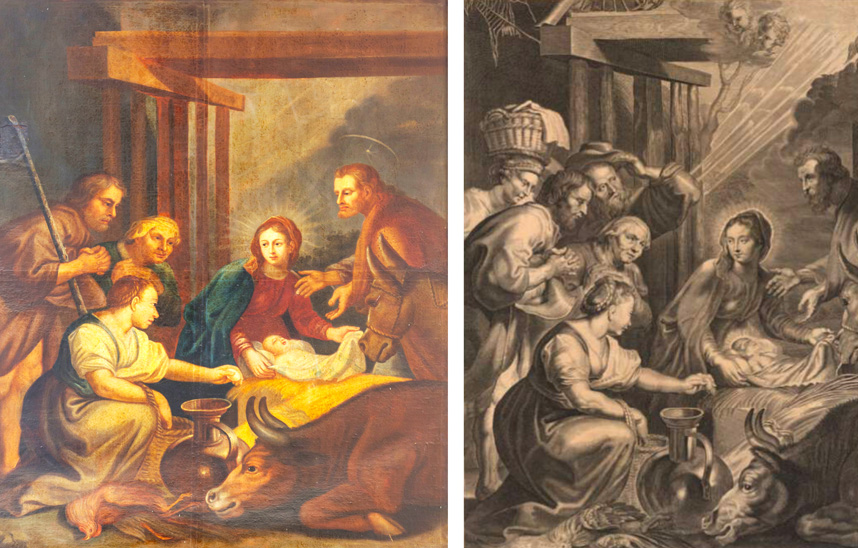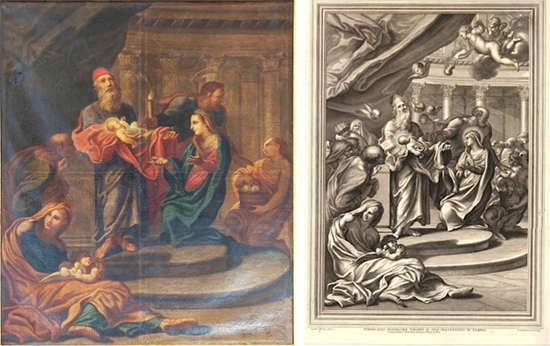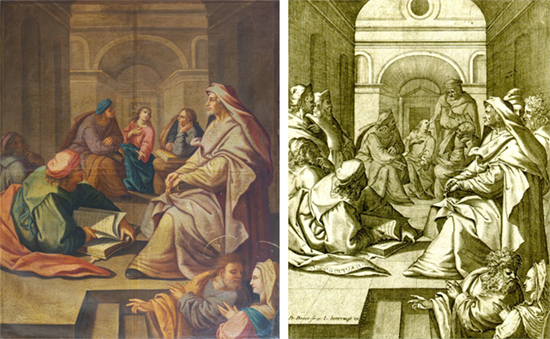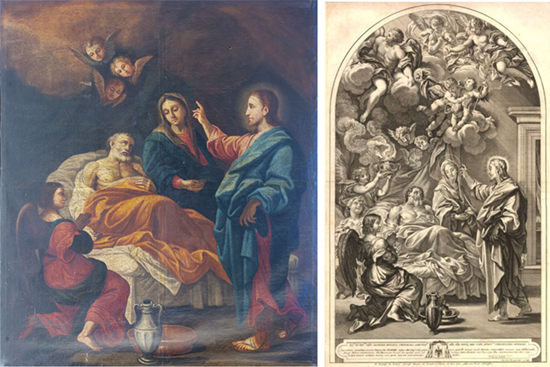The graphic sources of the painted series of St. Joseph in the Barefoot Carmelites of Pamplona

FotoManuelCastells/Adoración de los pastores en los Carmelitas Descalzos de Pamplona, by Pedro Antonio de Rada, c. 1765 and its model in Flemish engraving, after composition by Rubens, d. 1620.
If any saint has undergone a physical and moral transformation since the 16th century, it has been St. Joseph. As is well known, during the Age average, his figure was not relevant, far from it. He was represented then in some passages of the infancy of Christ, generally in capitals, keystones of doorways and cloisters and miniatures, as a sleepy old man. His image changed radically with the arrival of the centuries of Modernity, leaving behind a legendary iconographic model , according to some texts that presented him at eighty or ninety years of age, such as
an adult with a vigorous appearance and great moral strength, in keeping with a new vision of his role as the adoptive father of Christ. His figure began to have importance in the liturgy and in worship, highlighting his simplicity and tenderness. As a consequence, his projection in the arts did not take long to arrive.
Four were responsible for that transformation, all of them of great authority. The first was none other than the Chancellor of the University of Paris, the French Augustinian Jean Gerson (1363-1429), known as the doctor christianissimus, who wrote a poem graduate "Josephina", vindicating her figure. The second was the Dominican Isidoro Isolano, of greater projection, with his book published in Pavia in 1522, with the degree scroll of "Sum of the gifts of Saint Joseph". In his text he glossed the adoptive father of Christ as a man adorned with all subject of perfections, among them the seven gifts of the Holy Spirit and the eight beatitudes.
The third contribution, this time in core topic feminine, was the special devotion of St. Teresa of Jesus, who dedicated most of her foundations to him and wrote about him as follows: "I have not agreement until now begged him for anything that I have failed to do. It is something that frightens the great mercies that God has done to me through this blessed Saint, of the dangers that he has freed me, both in body and soul; that to other saints it seems that the Lord gave them grace to help in one need, to this glorious Saint I have experience that he helps in all and that the Lord wants to give us to understand that as he was subject to him on earth (that as he had the name of father, being a godfather, he could command him), so in heaven he does whatever he asks of him".
In full harmony with the testimony of the saint of Avila, we must point out in fourth place, her great friend and confidant, Father Jerónimo Gracián, who wrote the Summary of the Excellencies of the Glorious Saint Joseph, spouse of the Virgin Mary, published in Rome and dedicated to her carpenters in 1597.

presentation of the Child in the temple by Pedro Antonio de Rada, c. 1765 (Photo Manuel Castells) and its model in an engraving by François Louvemnont, after a painting by Carlo Maratta, published by Giovanni Giacomo de Rossi, 1660-1690.
Through these texts and a growing cult, his images were lavished as a strong and vigorous man, capable of protecting and protecting his family. His representations in solitary will abound greatly, accompanied by the Child Jesus, with some utensil of his official document, without, ordinarily, lacking the flowery rod, which is his attribute par excellence, coming from the Apocrypha.
The iconography of Saint Joseph is rich in Navarre. His paintings and even more his sculptures are abundant throughout Navarre, had a before and after following the determination of 1621 of Pope Gregory XV, ordering that his feast be celebrated throughout the Church on March 19. The centuries of the Baroque meant, in all the arts, an unprecedented development of its iconography.
The cycle of the Discalced Carmelites
Regarding the cycles, the only one that is currently preserved is the one that decorates the nave of the church of the Discalced Carmelites of the capital of Navarre, made under the care of Fray Bernardo de la Madre de Dios, prior of the convent of Pamplona on several occasions and provincial. The whole was possible thanks to a copious alms that his brother Don José Francisco Bigüézal, bishop of Ciudad Rodrigo between 1756 and 1762, had sent him. The realization must have been delayed until 1765, judging by a lawsuit that the friars maintained in relation to the patron of one of the chapels of the church. Its author was Pedro de Rada, a painter established in Pamplona in the second third of the eighteenth century and with extensive work, both in the sacristy of the cathedral, as well as in various commissions from the institutions of the Kingdom.

Jesús entre los doctores en los Carmelitas Descalzos de Pamplona, by Pedro Antonio de Rada, c. 1765 (Photo Manuel Castells) and his model in an engraving by Pedro Perret, according to the invention of Heyndrick Withouck, in the Historia infantiae Christi, Antwerp, 1591, 2nd edition Paris, 1591.
In the death certificate of the aforementioned Father Bernardo de la Madre de Dios (1767), we read, textually: "He was singularly devoted to N. P. S. Joseph and as a last expression of his affection he cooperated with a good alms that his brother the Bishop of Ciudad Rodrigo sent him for the expenses of six very / large and exquisite paintings, with their frames and carving all gilded, which with the History of the Saint have been placed in the church of this high school".
Five passages from the New Testament were included in the cycle: the Adoration of the Shepherds (Lk 2:8-20), the Circumcision of the Child Jesus (Lk 2:21), the presentation of the Child Jesus in the Temple (Lk 2:22-40), the Flight into Egypt (Mt 2:13-15, 19-23) and the Child Jesus lost and found in the Temple (Lk 2:41-52). To these scenes was added a sixth, with the topic of the death of St. Joseph, narrated in the Apocrypha and other texts quite widespread from the sixteenth century onwards.
The painter, like many others, based his compositions on engraved prints. However, despite what we might think, he did not use a specific series of prints, but rather each of the passages was copied from different intaglio prints that, most likely, were given to Pedro de Rada by the Carmelites themselves.
For the Adoration of the Shepherds a Flemish engraving of the Adoration of the Shepherds was used, very widespread, according to a composition by Rubens dated shortly after 1620. For the Circumcision and the Name of Jesus we have not located the graphic source , although everything seems to indicate that it would be the print of a missal that is behind the composition, in which occupies the upper third a large cloud with the anagram of the name of Jesus.
The canvas of the presentation of the Infant Jesus in the temple literally copies the intaglio print of the same topic made by François Louvemnont, after a painting by Carlo Maratta, published by Giovanni Giacomo de Rossi, 1660-1690. In the case of the Flight into Egypt, we find a very widespread outline for the representation of the above-mentioned passage in all painting since the sixteenth century. In the case of Jesus among the doctors, the engraving that is followed to the letter is that of Pedro Perret, according to Heyndrick Withouck's invention, with which the Historia infantiae Christi, Antwerp, 1591, in its second edition of Paris, 1591, was illustrated.

Death of St. Joseph in the Discalced Carmelites of Pamplona, by Pedro Antonio de Rada, c. 1765 (Photo Manuel Castells) and his model in an engraving by Nicolas Dorigny, according to model by Carlo Maratta, 1688.
The last painting of the cycle, dedicated as it could not be otherwise to the death of the saint, is a total copy of the engraving of topic made by Nicolas Dorigny, according to model by Carlo Maratta, 1688, in a compositional outline with a large foreshortening, which enjoyed great popularity, because devotionally it was in great demand as St. Joseph was invoked as the patron saint of the good death.
Like other series, this one of the Discalced Carmelites of the capital of Navarre, not only served to decorate the temple in its central nave, but also to fix the view on different mysteries linked to the life of the adoptive father of Christ and, consequently, to imitate that becoming full of silence and acceptance of the will of God, as his numerous panegyrists wrote and preached throughout the past centuries, in a process that did not stop growing until, in 1870, he was declared patron of the universal church.
